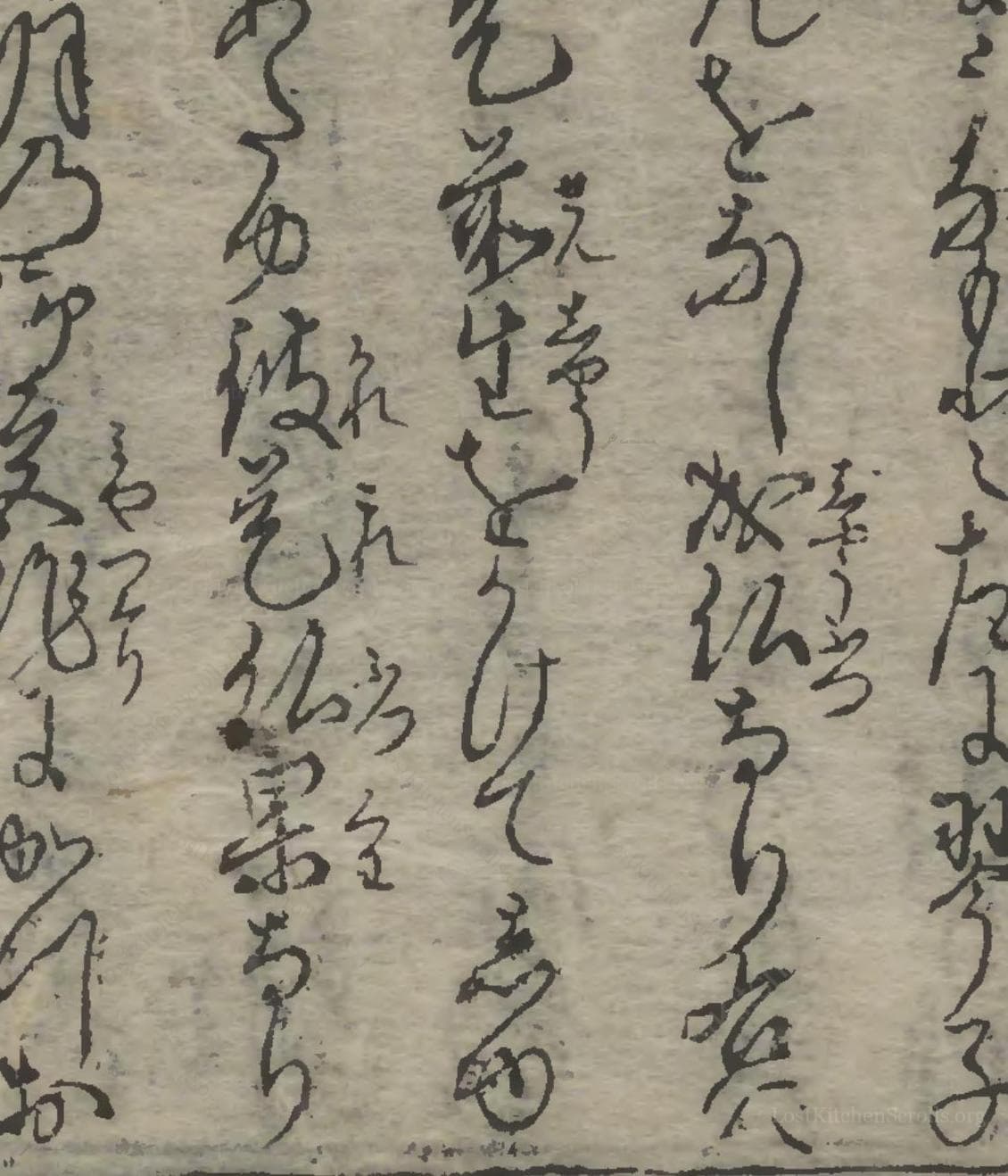
ちやんちやんとうふ 水法ちり煮
"からめぬき豆腐をだし汁にてそへ、やきしほよくきかせ、すゑて一煮。さてしやもじを以てよくよくかきまぜ、これハ津乃乃り見立よし。焼きて塗りてもよし。又付やきにてもよし。"
English Translation
"Remove the skin from the tofu and add it to a broth, seasoning well with grilled salt, then simmer briefly. Afterwards, use a paddle to mix thoroughly; this is good when arranged like Tsunonori. It is also good when grilled and coated, or even as a side dish for grilling."
Note on the Original Text
The recipe is written in classical Japanese style: economical, implicit, and tailored to readers already knowledgeable about daily kitchen practices. Precise quantities are omitted, as measurement by eye and experience was standard, and context was often supplied orally. The script contains period spellings such as 'ちやんちやん' (chan-chan), which would now be 'ちゃんちゃん', revealing changes in kana usage. The directions use visual cues ('resemble Tsunonori') rather than explicit instructions, requiring the cook to be familiar with local textures and finishes. The suggestion that the dish can also be broiled, baked, or served as a topping gives flexibility—a nod to the improvisational spirit of Edo-era home cooking.

Title
Ryōri shitsuke hō (1642)
You can also click the book image above to peruse the original tome
Writer
Unknown
Era
1642
Publisher
Nakamura Juemon
Background
A culinary gem from early Edo-period Japan, this block-printed manual serves up a fascinating glimpse into the art and etiquette of Japanese cooking, guiding readers through refined techniques and traditional recipes that delighted 17th-century palates.
Kindly made available by
Library of Congress
This recipe, 'Chanchan Tofu Mizuhō Chirini', hails from the 'Ryōri shitsuke hō', a Japanese cookbook published in 1642 during the Kan'ei era. This was a time when Japanese cuisine was refining its staple techniques and ingredients, with tofu having established a firm presence as a nutritious, easily flavored food. Such recipes reflected both the frugality and the ingenuity of early Edo period Japanese kitchens, emphasizing subtle flavors, texture, and the use of simple kitchen staples like dashi and salt. The inclusion of ways to 'bake' or 'broil' the dish also hints at the adaptability of these preparations to the means and tools available.

Cooks would have used wooden ladles, rice paddles, and thick-lipped iron pots (nabe) over a traditional hearth or open fire. A bamboo mat or pressing stones might have been used to press water from the tofu. Coarse roasted salt would be made by toasting salt in an iron pan over coals until aromatic and slightly golden. Earthenware or wooden bowls would serve for mixing and presentation. For the optional broiled or baked versions, a simple charcoal brazier or the residual coals of a hearth could provide the appropriate heat, with the tofu mixture sometimes spread on a wooden or ceramic plank for browning.
Prep Time
5 mins
Cook Time
10 mins
Servings
2
We've done our best to adapt this historical recipe for modern kitchens, but some details may still need refinement. We warmly welcome feedback from fellow cooks and culinary historians — your insights support the entire community!
Ingredients
- 14 oz soft or silken tofu (substitute: regular silken tofu, drained and lightly pressed)
- 2 cups dashi stock (can be made from kombu and bonito flakes, or substitute with vegetarian dashi for modern palates)
- 1 teaspoon roasted sea salt (or substitute with high-quality sea salt, briefly toasted in a pan for aroma)
- Optional: Additional seaweed for garnish or to mimic the 'Tsunonori' appearance
Instructions
- Begin by preparing soft tofu (about 14 oz); if possible, press it lightly to remove excess moisture, mimicking the 'karamenuki' or water-extracted tofu referenced in the original text.
- Bring 2 cups of dashi (Japanese soup stock) to a gentle simmer.
- Add the tofu and season generously with yaki-shio, meaning well-toasted or roasted salt (about 1 teaspoon).
- Allow everything to simmer briefly together.
- Once heated through, take a rice paddle or heat-proof spoon and stir or mash the tofu vigorously into the broth to break it down into a pleasingly nubby texture.
- The finished dish should resemble the appearance of 'Tsunonori' (a seaweed dish), as mentioned.
- Optionally, you may bake or broil the mixture further, or use it as a topping ('tsukeyaki') as the recipe suggests.
- Serve warm.
Estimated Calories
80 per serving
Cooking Estimates
You will spend about 5 minutes preparing the tofu and ingredients, and about 10 minutes cooking the soup. Each serving contains about 80 calories, and this recipe makes 2 servings.
As noted above, we have made our best effort to translate and adapt this historical recipe for modern kitchens, taking into account ingredients nowadays, cooking techniques, measurements, and so on. However, historical recipes often contain assumptions that require interpretation.
We'd love for anyone to help improve these adaptations. Community contributions are highly welcome. If you have suggestions, corrections, or cooking tips based on your experience with this recipe, please share them below.
Join the Discussion
Rate This Recipe
Dietary Preference
Main Ingredients
Occasions

Den Bockfisch In Einer Fleisch Suppen Zu Kochen
This recipe hails from a German manuscript cookbook compiled in 1696, a time whe...

Die Grieß Nudlen Zumachen
This recipe comes from a rather mysterious manuscript cookbook, penned anonymous...

Ein Boudain
This recipe comes from an anonymous German-language manuscript cookbook from 169...

Ein Gesaltzen Citroni
This recipe, dating from 1696, comes from an extensive anonymous German cookbook...
Browse our complete collection of time-honored recipes



